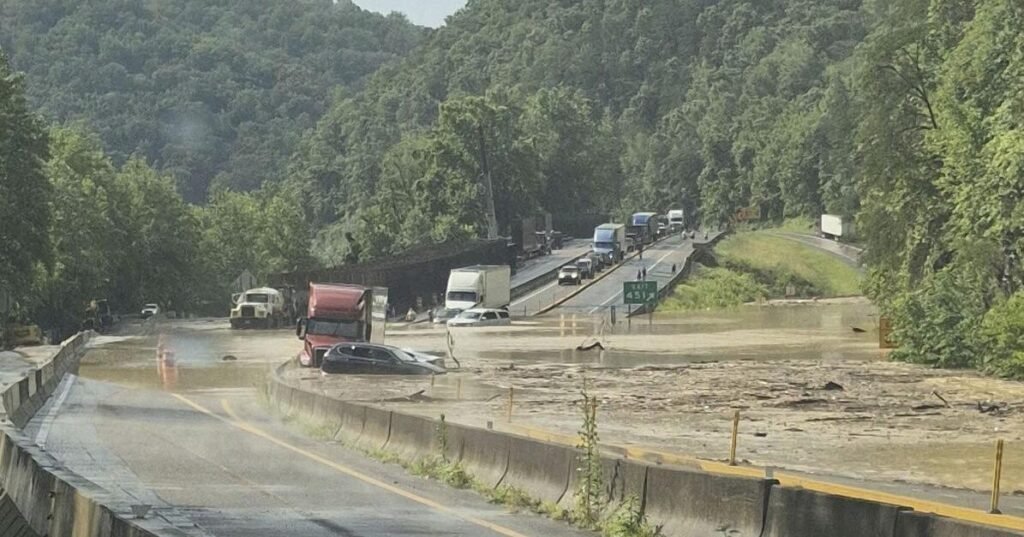Interstate 40 Closure: Heavy Rain, Flooding, and Rockslide Impact Great Smoky Mountains Highway
The scenic drive through the Great Smoky Mountains on Interstate 40 has once again been interrupted by nature’s powerful forces. As someone who’s been exploring and writing about the Smokies for over a decade, I’ve witnessed the delicate balance between this magnificent landscape and the infrastructure cutting through it. This latest closure reminds us just how vulnerable our mountain highways can be.
Current Situation: I-40 Closure Details
Heavy rainfall has triggered a significant rockslide along with extensive flooding, forcing officials to close a crucial section of Interstate 40 that winds through the narrow corridor of the Great Smoky Mountains. This vital cross-country highway connects the eastern and western United States, making this closure particularly impactful for both travelers and commerce.
Engineers are currently assessing the damage and working to clear debris while ensuring the safety of the roadway. This isn’t the first time this stretch has faced such challenges, but each closure brings unique concerns based on the severity of the damage.

Why This Area Is Particularly Vulnerable
I’ve often told visitors that the Pigeon River Gorge section of I-40 through the Smokies is both breathtakingly beautiful and geologically challenging. The highway was literally carved into the mountainside, creating steep cut slopes that are naturally prone to instability during heavy precipitation events.
Three factors make this corridor especially susceptible to closures:
- Steep terrain – The narrow passage through the mountains required extensive cutting into the natural landscape
- Geological composition – The regional rock formations have natural fracture planes that can become unstable when saturated
- Concentrated rainfall patterns – The Smokies create their own weather patterns, often resulting in intense localized rainfall
Historical Context of I-40 Mountain Closures
This isn’t unfamiliar territory for those of us who love and regularly travel through the Smokies. The I-40 corridor has experienced several significant closures over the years. The most dramatic occurred in October 2009 when a massive rockslide near the Tennessee/North Carolina border closed the interstate for six months, requiring extensive engineering work to stabilize the mountain.
| Year | Duration of Closure | Primary Cause |
|---|---|---|
| 2009-2010 | 6 months | Major rockslide |
| 2019 | 1 week | Rockslide after heavy rain |
| 2021 | 3 days | Flooding and debris |
| Present | Ongoing | Rockslide and flooding |
Impact on Travel and Local Communities
When I-40 closes in the Smokies, the effects ripple outward. Long-distance travelers must navigate significant detours, often adding hours to their journeys. For the small mountain communities nearby, these closures can mean both challenges and opportunities.
Local businesses in towns like Hartford, Tennessee and Hot Springs, North Carolina often experience decreased traffic from through-travelers. However, those same travelers sometimes become temporary visitors as they explore alternate routes, discovering charming mountain communities they might otherwise have bypassed at 70 mph.
Alternate Routes During the Closure
If you’re planning travel through the region, you’ll need to consider these primary detour options:
- I-26 to I-81 – The official detour route, adding approximately 45 minutes to the journey
- US-25/70 – A scenic but slower alternative through Hot Springs
- US-441 – Through Great Smoky Mountains National Park (not recommended for commercial vehicles)
Having driven all these routes countless times, I can tell you that while the detours can be frustrating, they also showcase some of the most beautiful landscapes in the Southeast that many travelers might otherwise miss.
The Engineering Challenges Ahead
The current closure highlights the ongoing battle between modern infrastructure needs and the powerful natural forces of the Smoky Mountains. Engineers are facing the immediate challenge of clearing debris and ensuring the roadway’s stability before reopening.
Long-term solutions might include enhanced drainage systems, additional rock netting on vulnerable slopes, and more comprehensive monitoring of potential slide areas. These mountain highways require constant vigilance and maintenance – something I’ve come to appreciate during my years exploring the region.
When Will Interstate 40 Reopen?
While officials haven’t yet provided a definitive timeline for reopening, similar past events suggest it could be anywhere from several days to weeks, depending on the extent of damage discovered during engineering assessments. The safety of travelers remains the primary concern guiding these decisions.
For the most current information, travelers should check with the North Carolina and Tennessee Departments of Transportation before planning trips through the area.
The Natural Beauty Worth Waiting For
Despite the inconvenience of these closures, I’m always reminded of why this mountain corridor is worth protecting and maintaining. The Great Smoky Mountains provide some of the most spectacular scenery in the eastern United States, with their misty ridgelines, diverse forests, and abundant wildlife.
Once the highway reopens, travelers will once again be treated to breathtaking views that make the journey special. In the meantime, the mountains remind us of their power and presence – something those of us who love the Smokies deeply respect.
Staying Informed About Mountain Travel Conditions
If you’re planning travel through the Great Smoky Mountains in the coming days or weeks, I recommend checking these resources for the most current information:
- North Carolina Department of Transportation (NCDOT) website or social media
- Tennessee Department of Transportation (TDOT) SmartWay information
- Local news outlets in Asheville and Knoxville
The mountains have their own rhythm and timeline. As someone who’s written about and explored these mountains for years, I’ve learned that patience is essential when dealing with the powerful forces of nature in the Smokies.

